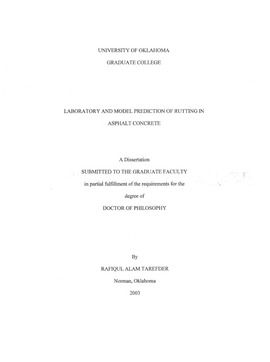| dc.contributor.advisor | Zaman, Musharraf, | en_US |
| dc.contributor.author | Tarefder, Rafiqul Alam. | en_US |
| dc.date.accessioned | 2013-08-16T12:19:04Z | |
| dc.date.available | 2013-08-16T12:19:04Z | |
| dc.date.issued | 2003 | en_US |
| dc.identifier.uri | https://hdl.handle.net/11244/640 | |
| dc.description.abstract | Rutting is one of the major distresses of flexible pavement. It is defined as the formation of longitudinal depressions under the wheel paths caused by the progressive movement of materials under traffic loading in the asphalt pavement layer, or in the underlying base, through consolidation or plastic flow. A safeguard is needed to protect asphalt pavements against rutting after opening roadways to traffic. Traditionally, predicting rutting performance of Hot Mix Asphalt (HMA) in the field has been a complicated task. In this study, a simpler method of determining rutting potential of HMA is employed that uses an Asphalt Pavement Analyzer (APA) in the laboratory. In the APA, rutting susceptibility is evaluated by subjecting HMA samples to moving wheel loads and measuring permanent deformation at selected points along the wheel path as a function of the number of loading cycles. The APA can simulate the field conditions (traffic load, temperature, etc.) of flexible pavements in the laboratory. Using the APA, a series of rut tests are performed on HMA mixes and these mixes are ranked based on their rut potentials. Pertinent mix properties (binder content, air voids), aggregate properties (angularity, size), asphalt binder properties (viscosity, grade), loading (wheel loads, hose pressure), and environment (temperature, wet/dry condition) that lead to differential rutting are identified. The factors affecting rutting are ranked based on their type and magnitude. Also, the correlation between resilient modulus and HMA rutting is examined. To this end, a comprehensive rut database containing APA rut values and factors affecting rutting potential of hundreds of HMA mixes is developed. Using this database, a neural network model is developed to predict rutting in HMA. The proposed neural network represents a mapping associating rutting potential of HMA with rut factors. Preprocessing and principal component analyses are applied to examine the significance of each rut-influencing parameter, and the network is trained using the Levenberg-Marquardt algorithm. Using randomly generated weight factors to initialize the training algorithm, histograms are compiled and outputs are estimated using statistical estimators. An excellent agreement is achieved between test data and simulations based on maximum likelihood estimator. The developed neural network is used to simulate the optimum asphalt content of a Superpave mix. It is expected that this method will be a useful tool for mix design for new pavements, as well as for rehabilitation of existing ones. | en_US |
| dc.format.extent | xxiv, 370 leaves : | en_US |
| dc.subject | Pavements Maintenance and repair. | en_US |
| dc.subject | Asphalt. | en_US |
| dc.subject | Biology, Neuroscience. | en_US |
| dc.subject | Geotechnology. | en_US |
| dc.subject | Pavements, Asphalt concrete. | en_US |
| dc.subject | Engineering, Civil. | en_US |
| dc.subject | Roads Maintenance and repair. | en_US |
| dc.title | Laboratory and model prediction of rutting in asphalt concrete. | en_US |
| dc.type | Thesis | en_US |
| dc.thesis.degree | Ph.D. | en_US |
| dc.thesis.degreeDiscipline | School of Civil Engineering and Environmental Science | en_US |
| dc.note | Source: Dissertation Abstracts International, Volume: 64-09, Section: B, page: 4511. | en_US |
| dc.note | Adviser: Musharraf Zaman. | en_US |
| ou.identifier | (UMI)AAI3104294 | en_US |
| ou.group | College of Engineering::School of Civil Engineering and Environmental Science | |
